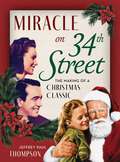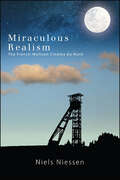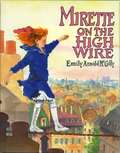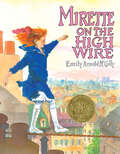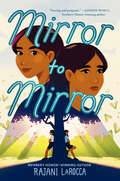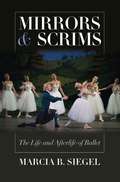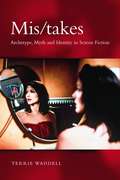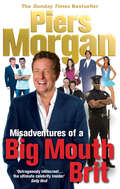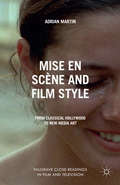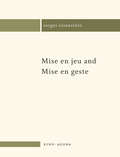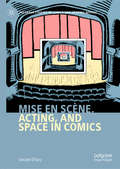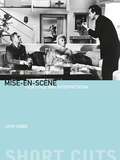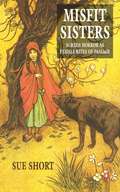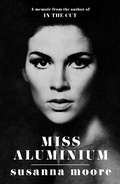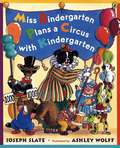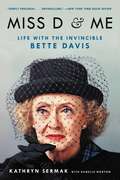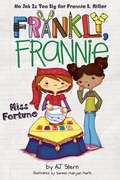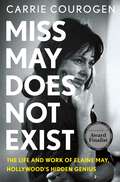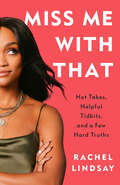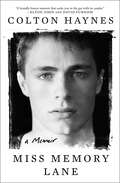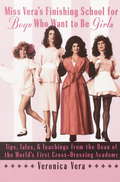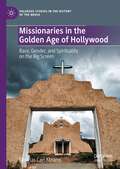- Table View
- List View
Miracle on 34th Street: The Making of a Christmas Classic
by Jeffrey Paul ThompsonDespite having been made into three TV movies, a radio drama, a stage play, a Broadway musical, a feature-film remake in color, and a book adaptation, the 1947 black-and-white film of Miracle on 34th Street still remains the favorite version of this modern Christmas classic. The American public seems to echo what Macy&’s stated when declining to participate in the 1994 remake: &“We felt there was nothing to be improved upon.&” In many ways, it is a perfect film in the sense that there really is nothing that could have been done better: the story, the casting, the acting were all spot-on. The decade from 1941–1951 saw a bumper crop of classic Christmas including Christmas in Connecticut, Holiday Inn, and It&’s a Wonderful Life, but with the exception of the latter film none have had the staying power of Miracle on 34th Street.This book describes the origins of the story, the casting and production of the film, its marketing and publicity, and even how it elevated the Macy&’s Thanksgiving Day Parade from a local New York event to a national celebration. Finally, it looks at the film&’s legacy, including its high ranking among best Christmas movies of all time as well as its placement as ninth overall on the American Film Institute&’s list of the most inspiring films.
Miracles and Sacrilege
by William Bruce JohnsonMiracles and Sacrilege is the story of the epochal conflict between censorship and freedom in film, recounted through an in-depth analysis of the U.S. Supreme Court?s decision striking down a government ban on Roberto Rossellini?s film The Miracle (1950). In this extraordinary case, the Court ultimately chose to abandon its own longstanding determination that film comprised a mere ?business? unworthy of free-speech rights, declaring for the first time that the First Amendment barred government from banning any film as ?sacreligious.?Using legal briefs, affidavits, and other court records, as well as letters, memoranda, and other archival materials to elucidate what was at issue in the case, William Bruce Johnson also analyzes the social, cultural, and religious elements that form the background of this complex and hard-fought controversy, focusing particularly on the fundamental role played by the Catholic Church in the history of film censorship. Tracing the development of the Church in the United States, Johnson discusses the reasons it found The Miracle sacrilegious and how it attained the power to persuade civil authorities to ban it. The Court?s decision was not only a milestone in the law of church-state relations, but it paved the way for a succession of later decisions which gradually established a firm legal basis for freedom of expression in the arts.
Miraculous Realism: The French-Walloon Cinéma du Nord (SUNY series, Horizons of Cinema)
by Niels NiessenAt the 1999 Cannes Film Festival, two movies from northern-Francophone Europe swept almost all the main awards. Rosetta by the Walloon directors Jean-Pierre and Luc Dardenne won the Golden Palm, and L'humanité by the French director Bruno Dumont won the Grand Prize; both won acting awards as well. Taking this "miracle" of Cannes as the point of departure, Niels Niessen identifies a transregional film movement in the French-Belgian border region—the Cinéma du Nord or "cinema of the North." He examines this movement within the contexts of French and Belgian national cinemas from the silent era to the digital age, as well as that of the new realist tendency in world cinema of the last three decades. In addition, he traces, from a northern perspective, a secular-religious tradition in Francophone-European film and philosophy from Bresson and Pialat, via Bazin, Deleuze, and Godard, to the Dardennes and Dumont, while critiquing this tradition for its frequent use of a humanist vocabulary of grace for a secular world. Once a cradle of the Industrial Revolution, the Franco-Belgian Nord faced economic crisis for most of the twentieth century. Miraculous Realism demonstrates that the Cinéma du Nord's rise to prominence resulted from the region's endeavor to reinvent itself economically and culturally at the crossroads of Europe after decades of recession.
Mirette On the High Wire
by Emily MccullyWinner of the 1993 Caldecott Medal. One day, a mysterious stranger arrives at the boardinghouse of the widow Gâteau-a sad-faced stranger, who keeps to himself. When the widow's daughter, Mirette, discovers him crossing the courtyard on air, she begs him to teach her how he does it. But Mirette doesn't know that the stranger was once the Great Bellini- master wire-walker. Or that Bellini has been stopped by a terrible fear. And it is she who must teach him courage once again. Emily Arnold McCully's sweeping watercolor paintings carry the reader over the rooftops of nineteenth-century Paris, and into an elegant, beautiful world of acrobats, jugglers, mimes, actors, and one gallant, resourceful little girl.
Mirette on the High Wire
by Emily Arnold McCullyOne day, a mysterious stranger arrives at a boardinghouse of the widow Gateau- a sad-faced stranger, who keeps to himself. When the widow's daughter, Mirette, discovers him crossing the courtyard on air, she begs him to teach her how he does it.But Mirette doesn't know that the stranger was once the Great Bellini- master wire-walker. Or that Bellini has been stopped by a terrible fear. And it is she who must teach him courage once again.Emily Arnold McCully's sweeping watercolor paintings carry the reader over the rooftops of nineteenth-century Paris and into an elegant, beautiful world of acrobats, jugglers, mimes, actors, and one gallant, resourceful little girl.
Mirror to Mirror
by Rajani LaRoccaRajani LaRocca, recipient of a Newbery Honor and Walter Award for Red, White, and Whole, is back with an evocative novel in verse about identical twin sisters who do everything together—until external pressures threaten to break them apart.Maya is the pragmatic twin, but her secret anxiety threatens to overwhelm her.Chaya is the outgoing twin. When she sees her beloved sister suffering, she wants to tell their parents—which makes Maya feel completely betrayed. With Maya shutting her out, Chaya makes a dramatic change to give her twin the space she seems to need. But that’s the last thing Maya wants, and the girls just drift further apart.The once-close sisters can’t seem to find their rhythm, so they make a bet: they’ll switch places at their summer camp, and whoever can keep the ruse going longer will get to decide where they both attend high school—the source of frequent arguments. But stepping into each other’s shoes comes with its own difficulties, and the girls don’t know how they’re going to make it.This emotional, lyrical story will speak to fans of Ali Benjamin, Padma Venkatraman, and Jasmine Warga.
Mirrors and Scrims
by Marcia B. SiegelIn this stunning new collection of reviews and essays, dance critic Marcia B. Siegel grapples with the floating identity of ballet, as well as particular ballets, and with the expanding environment of spectacle in which ballet competes for an audience. Drawn from a wide variety of published sources, these writings concentrate on canonical works of ballet and how the performances of these works have been changing in significant ways. Siegel writes with a keen awareness of the history and mythology that surround particular works, while remaining attentive to the new ways in which a work is interpreted and re-presented by contemporary choreographers and dancers. Through her readable and provocative writings, Siegel offers critical insight into performances of the past twenty-five years to give us a new understanding of ballet in performance. The volume includes over one hundred pieces on a variety of ballet topics, from specific dances and dancers to companies and choreographers, ranging from Swan Lake and The Nutcracker to Nijinsky, Balanchine, Tharp, and Morris to the Bolshoi, the Joffrey, the Miami City Ballet, the Boston Ballet, to name just a few.
Mis/takes: Archetype, Myth and Identity in Screen Fiction
by Terrie WaddellMis/takes departs from the bulk of screen discourse by applying Jungian and Post-Jungian ideas on unconscious processes to popular film and television. This perspective offers a rich insight into the way that various myths infiltrate popular culture. By examining the function of psychological motifs and symbols in cinema and television, Terrie Waddell opens up another way of thinking about how identity can be constructed and disrupted. Mulholland Drive, Memento, The Others, The X-Files, Twin Peaks, The Sopranos, Spider, Intimacy and Absolutely Fabulous all lend themselves to this approach. The close analysis of these films/programs are guided by a number of core archetypes from trickster and Self to incest and the grotesque. The book’s four parts reflect these dominant patterns: Jung, trickster and the screen Mistaken identities, self-deception and the undead Redeemers, bad dads and matricide Excesses of the sad and the sassy Mis/takes gives readers a chance to engage with screen material in an original and subversive way. This study will be of great interest to Jungian analysts and students of film, cultural studies, media, gender studies and analytical psychology.
Misadventures of a Big Mouth Brit
by Piers MorganPiers has got a new job. He's off to America to be the 'Nasty Brit' judging the show America's Got Talent - surely a role he was made for? And with unprecedented access to people, places and parties on both sides of the pond, he'll get the inside scoop on the world of celebrity Stateside. So what could possibly go wrong?Well, it's not all plain sailing. Piers finds himself snubbed by the paparazzi and subjected to national ridicule by Alan Sugar. As well as foolishly embarking on a visit to the Playboy Mansion with his girlfriend he also becomes one of the only people to fall off the 'idiot-proof' Segway (George Bush fell off one too).Somehow though, Piers still manages to get invited to all the best parties. Perhaps because he keeps being mistaken for David Cameron? From chinwags with Naomi Campbell to a cigar-smoking session with Arnold Schwarzenegger; hilarious tête-à-têtes with everyone from Boris Johnson to Cheryl Cole; and many bizarre encounters with the likes of Paris Hilton, Tony Blair and Jay-Z, Piers is his usual candid, honest, loudmouth self as he lifts the lid on Tinsel Town.With the background cries of 'Please don't embarrass us Dad!' from his sons, the Big Mouth Brit embarks on his hilarious American adventure, and suffers just a few mishaps along the way.
Mise en Scène and Film Style: From Classical Hollywood to New Media Art (Palgrave Close Readings in Film and Television)
by A. MartinStyles of filmmaking have changed greatly from classical Hollywood through to our digital era. So, too, have the ways in which film critics and scholars have analysed these transformations in film style. This book explores two central style concepts, mise en scène and dispositif, to illuminate a wide range of film and new media examples.
Mise en Scène and Film Style: From Classical Hollywood to New Media Art (Palgrave Close Readings in Film and Television)
by Adrian MartinStyles of filmmaking have changed greatly from classical Hollywood through to our digital era. So, too, have the ways in which film critics and scholars have analysed these transformations in film style. This book explores two central style concepts, mise en scène and dispositif, to illuminate a wide range of film and new media examples.
Mise en jeu and Mise en geste
by Sergei EisensteinMise en jeu and Mise en geste was composed in January 1948, a few months before Sergei Eisenstein's untimely death. Here Eisenstein insists on subordinating all aspects of mise en scène to some unifying idea or principle inherent in the subject matter, transforming it from an incoherent jumble of staging decisions into a "legible text," wherein the subtext of a given scene or event – its hidden meaning – may be writ large. Unlike Eisenstein's previous writings on mise en scène, this essay treats separately distinct elements of that notoriously catch-all category: mise en jeu (transposition "of the interplay of motives" into a sequence of concrete actions); mise en geste (transposition of character into gesture); and mise en cadre (recreating the specific effects of a poetic passage through shot composition). Unfinished at the time of his death, the essay has been reconstructed by the Eisenstein Centre in Moscow and is appearing here in English for the first time. "[Filming Balzac's Père Goriot] is just like declaiming verse. A little too much emphasis on the period of the rhythm, and the recitation turns into a lifeless mechanical drone. A touch too slack on rhythmic delivery, and the distinct cadence of verse disintegrates into the baffling formlessness of semi-prose. A little too much emphasis on the circle [formed by the characters], and the mise en scène starts to lean towards ballet and conventional theatre. A bit too careless with the geometric figure, and the clear, distinct, meaningful mise en scène is sucked into the swamp of formless naturalism." — Sergei Eisenstein
Mise en scène, Acting, and Space in Comics (Palgrave Studies in Comics and Graphic Novels)
by Geraint D'ArcyThis book explores some of the less frequently questioned ideas which underpin comics creation and criticism. “Mise en scène” is a term which refers to the way in which visual elements work together to create meaning in comics. It is a term that comics have borrowed from cinema, which borrowed it in turn from theatre. But comics are not film and they are not cinema, so how can this term be of any use? If we consider comics to have mise en scène, should not we also ask if the characters in comics act like the characters on film and stage? In its exploration of these ideas, this book also asks what film and theatre can learn from comics.
Mise-en-scène: Film Style and Interpretation
by John GibbsJohn Gibbs is lecturer in film and television studies at the London College of Printing, the London Institute.
Mise-en-scène: Film Style and Interpretation (Short Cuts)
by John GibbsMise-en-scène: Film Style and Interpretation explores and elucidates constructions of this fundamental concept in thinking about film. In uncovering the history of mise-en-scène within film criticism, and through the detailed exploration of scenes from films as Imitation of Life and Lone Star, John Gibbs makes the case for the importance of a sensitive understanding of film style, and provides an introduction to the skills of close reading. This book thus celebrates film-making as well as film criticism that is alive to the creative possibilities of visual style.
Misfit Sisters: Screen Horror as Female Rites
by Sue ShortFeminist readings of horror television and movies from the past decade, including "Buffy the Vampire Slayer," exploring the links to fairy tales.
Miss Aluminium: ONE OF THE SUNDAY TIMES' 100 BEST SUMMER READS OF 2020
by Susanna MooreONE OF THE SUNDAY TIMES' 100 BEST SUMMER READS OF 2020'Unlike any Hollywood memoir you'll have read' Metro'It's hard to beat Susanna Moore's Miss Aluminium' Vogue'A sharp-edged summery treat' Hadley FreemanAt seventeen, Susanna Moore left her home in Hawai'i, with no money, no belongings and no prospects. But in Philadelphia, an unexpected gift of four trunks of beautiful clothes allowed her to assume the first of many disguises. Her journey takes her from New York to Los Angeles where she becomes a model and meets Joan Didion and Audrey Hepburn. She works as a script reader for Warren Beatty and Jack Nicholson, and is given a screen test by Mike Nichols. But beneath Miss Aluminium's glittering fairytale surface lies the story of a girl's insatiable hunger to learn. Moore gives us a sardonic, often humorous portrait of Hollywood in the seventies and of a young woman's hard-won arrival at selfhood.
Miss Bindergarten Plans a Circus With Kindergarten (Miss Bindergarten Bks.)
by Joseph SlateMiss Bindergarten is planning a circus and all of her kindergarteners are in on the fun! Everyone is busy preparing: painting posters, practicing somersaults, and making popcorn balls. When at last the big day arrives, there will be a parade, complete with clowns and stunts, from baton twirling to "high-wire" walking. And for the grand finale, Miss Bindergarten will give the audience a spectacular, show-stopping act!
Miss D and Me: Life with the Invincible Bette Davis
by Danelle Morton Kathryn SermakFor ten years Kathryn Sermak was at Bette Davis's side--first as an employee, and then as her closest friend--and in Miss D and Me she tells the story of the great star's harrowing but inspiring final years, a story fans have been waiting decades to hear. Miss D and Me is a story of two powerful women, one at the end of her life and the other at the beginning. As Bette Davis aged she was looking for an assistant, but she found something more than that in Kathryn: a loyal and loving buddy, a co-conspirator in her jokes and schemes, and a competent assistant whom she trained never to miss a detail. But Miss D had strict rules for Kathryn about everything from how to eat a salad to how to wear her hair...even the spelling of Kathryn's name was changed (adding the "y") per Miss D's request. Throughout their time together, the two grew incredibly close, and Kathryn had a front-row seat to the larger-than-life Davis's career renaissance in her later years, as well as to the humiliating public betrayal that nearly killed Miss D. The frame of this story is a four-day road trip Kathryn and Davis took from Biarritz to Paris, during which they disentangled their ferocious dependency. Miss D and Me is a window into the world of the unique and formidable Bette Davis, told by the person who perhaps knew her best of all.
Miss Fortune
by Aj Stern Doreen Mulryan MartsFrannie's parents throw a party for Frannie with a fortune teller and Frannie finds her next new job: fortune teller, obviously! Frannie begins making up the fortunes of her friends at school and realizes that there is a difference between seeing the future and simply telling people what to do. After Frannie's customers start taking their fortunes too seriously by refusing to shower, do their chores, and even go to school, Frannie discovers that being psychic wasn't her hidden talent after all. And that is not an opinion!
Miss May Does Not Exist: The Life and Work of Elaine May, Hollywood’s Hidden Genius
by Carrie CourogenMiss May Does Not Exist, by Carrie Courogen is the riveting biography of comedian, director, actor and writer Elaine May, one of America’s greatest comic geniuses. May began her career as one-half of the legendary comedy team known as Nichols and May, the duo that revolutionized the comedy sketch.After performing their Broadway smash An Evening with Mike Nichols and Elaine May, Elaine set out on her own. She toiled unsuccessfully on Broadway for a while, but then headed to Hollywood where she became the director of A New Leaf, The Heartbreak Kid, Mikey and Nicky, and the legendary Ishtar. She was hired as a script doctor on countless films like Heaven Can Wait, Reds, Tootsie, and The Birdcage. In 2019, she returned to Broadway where she won the Tony Award for Best Leading Actress in The Waverly Gallery. Besides her considerable talent, May is well known for her reclusiveness. On one of the albums she made with Mike Nichols, her bio is this: “Miss May does not exist.” Until now.Carrie Courogen has uncovered the Elaine May who does exist. Conducting countless interviews, she has filled in the blanks May has forcibly kept blank for years, creating a fascinating portrait of the way women were mistreated and held back in Hollywood. Miss May Does Not Exist is a remarkable love story about a prickly genius who was never easy to work with, not always easy to love and frequently often punished for those things, despite revolutionizing the way we think about comedy, acting, and what a film or play can be.
Miss Me with That: Hot Takes, Helpful Tidbits, and a Few Hard Truths
by Rachel LindsayA candid, witty, and inspiring collection of essays from The Bachelor&’s first Black Bachelorette, exploring everything from relationships and love to politics and race &“The Bachelor gave me an opportunity, but I created my own happy ending.&” ONE OF THE MOST ANTICIPATED BOOKS OF 2022—Essence, She ReadsRachel Lindsay rose to prominence as The Bachelor&’s first Black Bachelorette and has since become one of the franchise&’s most well-known figures—and outspoken critics. But there has always been more to Lindsay than meets the eye, and in this book, she finally tells her own story, in her own words. In wide-ranging essays, Lindsay opens up about her experience on ABC&’s hit show and reveals everything about her life off-camera, from a childhood growing up in Dallas, Texas, as the daughter of a U.S. District Judge, to her disastrous dating life prior to appearing on The Bachelor, to her career in law, and the decision to become a reality-TV contestant. She also brings a sharp wit and keen intellect to weigh in on issues such as the lack of diversity in reality television and the importance of political engagement, protest, and the Black Lives Matter movement.Told in the down-to-earth, no-nonsense voice she&’s become known for, Lindsay&’s book of essays provides an intimate look at the life of one of reality TV&’s most beloved stars, as well as advice and inspiration that will make her a role model for anyone who has ever struggled to find their way in love and life. As she says, &“Contrary to popular belief, the best gift I ever received was not a wedding ring. It was the permission I gave myself to be imperfect.&” And if you don&’t believe her, you know the saying: Miss me with that.
Miss Memory Lane: A Memoir
by Colton HaynesA brutally honest and moving memoir of lust, abuse, addiction, stardom, and redemption from Arrow and Teen Wolf actor Colton Haynes.Four years ago, Colton Haynes woke up in a hospital. He&’d had two seizures, lost the sight in one eye, almost ruptured a kidney, and been put on an involuntary psychiatry hold. Not yet thirty, he knew he had to take stock of his life and make some serious changes if he wanted to see his next birthday. As he worked towards sobriety, Haynes allowed himself to become vulnerable for the first time in years and with that, discovered profound self-awareness. He had millions of social media followers who constantly told him they loved him. But what would they think if they knew his true story? If they knew where he came from and the things he had done? Now, Colton bravely pulls back the curtain on his life and career, revealing the incredible highs and devastating lows. From his unorthodox childhood in a small Kansas town, to coming to terms with his sexuality, he keeps nothing back. By sixteen, he had been signed by the world&’s top modeling agency and his face appeared on billboards. But he was still a broke, lonely, confused teenager, surrounded by people telling him he could be a star as long as he never let anyone see his true self. As his career in television took off, the stress of wearing so many masks and trying to please so many different people turned his use of drugs and alcohol into full-blown addiction. A lyrical and intimate confession, apology, and cautionary tale, Miss Memory Lane is an unforgettable story of dreams deferred and dreams fulfilled; of a family torn apart and rebuilt; and of a man stepping into the light as no one but himself.
Miss Vera's Finishing School for Boys Who Want to Be Girls
by Veronica VeraIt is estimated that three to five percent of the adult male population of the United States feels the need, at least occasionally, to dress in women's clothing. Judging from enrollment at her academy, Miss Vera would say that figure is low.Veronica Vera founded Miss Vera's Finishing School for Boys Who Want to Be Girls in 1992 and started a gender revolution. Working from the pink palace of the Academy's intimate Manhattan campus, she has helped hundreds of students embrace and master Venus Envy through her expert instruction in the arts of dressing up, making up, going out, and acting like a lady. In her new book, she shares her priceless wisdom with the world.With sparkling wit and dazzling insight, Miss V gives us the 411 on body hair, foundation garments, make-up, and dressing, as well as offering invaluable advice on Creating a Herstory (finding the real life story of the femmeself within) speech, manners, walking in high heels, and--that biggest step of all--going out in the real world all dressed up. Amply illustrated and filled with the real stories of students and graduates, Miss Vera's Finishing School also offers a fascinating history of how the Academy came to be, as well as Miss Vera's own incisive gender manifesto."As we step boldly toward the new millennium, many more of us will be doing it in high heels," says Veronica Vera. In Miss Vera's Finishing School for Boys Who Want to Be Girls, she proves conclusively that, after a long day in wingtips, there's nothing like slipping into a pair of spiked heels.From the Trade Paperback edition.
Missionaries in the Golden Age of Hollywood: Race, Gender, and Spirituality on the Big Screen (Palgrave Studies in the History of the Media)
by Douglas Carl AbramsThis book examines major British and American missionary films during the Golden Age of Hollywood to explore the significance of race, gender, and spirituality in relation to the lives of the missionaries portrayed in film during the middle third of the twentieth century. Film both influences and reflects culture, and racial, gender, and religious identities are some of the most debated issues globally today. In the movies explored in this book, missionary interactions with various people groups reflect the historical changes which took place during this time.
